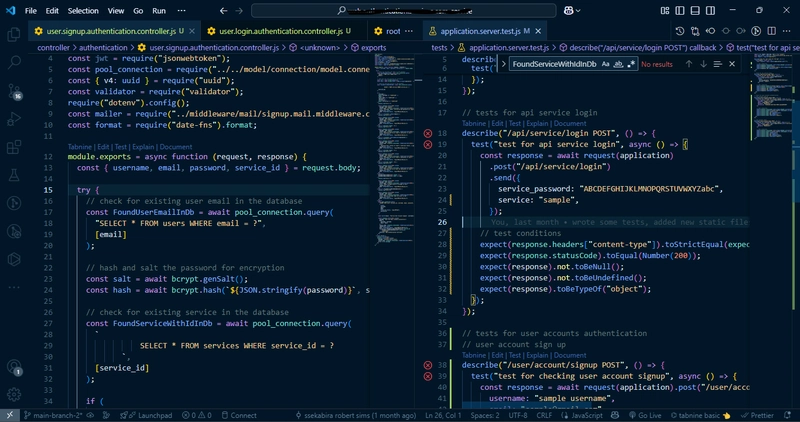Product of Array Expect Itself Leetcode Question - 238
Given an integer array nums, return an array answer such that answer[i] is equal to the product of all the elements of nums except nums[i]. The product of any prefix or suffix of nums is guaranteed to fit in a 32-bit integer. You must write an algorithm that runs in O(n) time and without using the division operation. Example 1: Input: nums = [1,2,3,4] Output: [24,12,8,6] Example 2: Input: nums = [-1,1,0,-3,3] Output: [0,0,9,0,0] Solution Approach: Prefix and Postfix Products My solution uses a two-pass approach utilizing prefix and postfix products to efficiently solve the problem in O(n) time with O(1) extra space (excluding the output array). Key Insight Prefix product: The product of all elements to the left of the current element Postfix product: The product of all elements to the right of the current element The product of all elements except the current one is: prefix × postfix Algorithm Initialize a result array of the same size as the input array First pass: Calculate prefix products from left to right Second pass: Calculate postfix products from right to left, while multiplying with the existing prefix products Visualization For example, with input array nums = [1, 2, 3, 4]: First Pass (Prefix Products): Start with prefix = 1 For each position, store the current prefix in the result array, then update the prefix After first pass, result = [1, 1, 2, 6] Second Pass (Postfix Products): Start with postfix = 1 For each position (in reverse), multiply the existing value by the current postfix, then update the postfix After second pass, result = [24, 12, 4, 1] This gives us our answer, as each position now contains the product of all elements except the one at that position. Code Implementation Approach: Prefix and Postfix Products My solution uses a two-pass approach utilizing prefix and postfix products to efficiently solve the problem in O(n) time with O(1) extra space (excluding the output array). Key Insight Prefix product: The product of all elements to the left of the current element Postfix product: The product of all elements to the right of the current element The product of all elements except the current one is: prefix × postfix Algorithm Initialize a result array of the same size as the input array First pass: Calculate prefix products from left to right Second pass: Calculate postfix products from right to left, while multiplying with the existing prefix products Visualization For example, with input array nums = [1, 2, 3, 4]: First Pass (Prefix Products): Start with prefix = 1 For each position, store the current prefix in the result array, then update the prefix After first pass, result = [1, 1, 2, 6] Second Pass (Postfix Products): Start with postfix = 1 For each position (in reverse), multiply the existing value by the current postfix, then update the postfix After second pass, result = [24, 12, 4, 1] This gives us our answer, as each position now contains the product of all elements except the one at that position. Code Implementation My solution uses a two-pass approach utilizing prefix and postfix products to efficiently solve the problem in O(n) time with O(1) extra space (excluding the output array). Key Insight Prefix product: The product of all elements to the left of the current element Postfix product: The product of all elements to the right of the current element The product of all elements except the current one is: prefix × postfix Algorithm Initialize a result array of the same size as the input array First pass: Calculate prefix products from left to right Second pass: Calculate postfix products from right to left, while multiplying with the existing prefix products Visualization For example, with input array nums = [1, 2, 3, 4]: First Pass (Prefix Products): Start with prefix = 1 For each position, store the current prefix in the result array, then update the prefix After first pass, result = [1, 1, 2, 6] Second Pass (Postfix Products): Start with postfix = 1 For each position (in reverse), multiply the existing value by the current postfix, then update the postfix After second pass, result = [24, 12, 4, 1] This gives us our answer, as each position now contains the product of all elements except the one at that position. Code Implementation func productExceptSelf(nums []int) []int { // result array of the same size as input array res := make([]int,len(nums)) //calculate prefix prefix :=1 for i,v := range nums{ res[i] = prefix prefix *= v } // Calculate postfix products and multiply with prefix products postfix := 1 for i := len(nums)-1; i >= 0 ; i--{ res[i] *= postfix postfix *= nums[i] } return res }

Given an integer array nums, return an array answer such that answer[i] is equal to the product of all the elements of nums except nums[i].
The product of any prefix or suffix of nums is guaranteed to fit in a 32-bit integer.
You must write an algorithm that runs in O(n) time and without using the division operation.
Example 1:
Input: nums = [1,2,3,4]
Output: [24,12,8,6]
Example 2:
Input: nums = [-1,1,0,-3,3]
Output: [0,0,9,0,0]
Solution
Approach: Prefix and Postfix Products
My solution uses a two-pass approach utilizing prefix and postfix products to efficiently solve the problem in O(n) time with O(1) extra space (excluding the output array).
Key Insight
Prefix product: The product of all elements to the left of the current element
Postfix product: The product of all elements to the right of the current element
The product of all elements except the current one is: prefix × postfix
Algorithm
Initialize a result array of the same size as the input array
First pass: Calculate prefix products from left to right
Second pass: Calculate postfix products from right to left, while multiplying with the existing prefix products
Visualization
For example, with input array nums = [1, 2, 3, 4]:
First Pass (Prefix Products):
Start with prefix = 1
For each position, store the current prefix in the result array, then update the prefix
After first pass, result = [1, 1, 2, 6]
Second Pass (Postfix Products):
Start with postfix = 1
For each position (in reverse), multiply the existing value by the current postfix, then update the postfix
After second pass, result = [24, 12, 4, 1]
This gives us our answer, as each position now contains the product of all elements except the one at that position.
Code Implementation
Approach: Prefix and Postfix Products
My solution uses a two-pass approach utilizing prefix and postfix products to efficiently solve the problem in O(n) time with O(1) extra space (excluding the output array).
Key Insight
Prefix product: The product of all elements to the left of the current element
Postfix product: The product of all elements to the right of the current element
The product of all elements except the current one is: prefix × postfix
Algorithm
Initialize a result array of the same size as the input array
First pass: Calculate prefix products from left to right
Second pass: Calculate postfix products from right to left, while multiplying with the existing prefix products
Visualization
For example, with input array nums = [1, 2, 3, 4]:
First Pass (Prefix Products):
Start with prefix = 1
For each position, store the current prefix in the result array, then update the prefix
After first pass, result = [1, 1, 2, 6]
Second Pass (Postfix Products):
Start with postfix = 1
For each position (in reverse), multiply the existing value by the current postfix, then update the postfix
After second pass, result = [24, 12, 4, 1]
This gives us our answer, as each position now contains the product of all elements except the one at that position.
Code Implementation
My solution uses a two-pass approach utilizing prefix and postfix products to efficiently solve the problem in O(n) time with O(1) extra space (excluding the output array).
Key Insight
Prefix product: The product of all elements to the left of the current element
Postfix product: The product of all elements to the right of the current element
The product of all elements except the current one is: prefix × postfix
Algorithm
Initialize a result array of the same size as the input array
First pass: Calculate prefix products from left to right
Second pass: Calculate postfix products from right to left, while multiplying with the existing prefix products
Visualization
For example, with input array nums = [1, 2, 3, 4]:
First Pass (Prefix Products):
Start with prefix = 1
For each position, store the current prefix in the result array, then update the prefix
After first pass, result = [1, 1, 2, 6]
Second Pass (Postfix Products):
Start with postfix = 1
For each position (in reverse), multiply the existing value by the current postfix, then update the postfix
After second pass, result = [24, 12, 4, 1]
This gives us our answer, as each position now contains the product of all elements except the one at that position.
Code Implementation
func productExceptSelf(nums []int) []int {
// result array of the same size as input array
res := make([]int,len(nums))
//calculate prefix
prefix :=1
for i,v := range nums{
res[i] = prefix
prefix *= v
}
// Calculate postfix products and multiply with prefix products
postfix := 1
for i := len(nums)-1; i >= 0 ; i--{
res[i] *= postfix
postfix *= nums[i]
}
return res
}








































































































































































![[The AI Show Episode 143]: ChatGPT Revenue Surge, New AGI Timelines, Amazon’s AI Agent, Claude for Education, Model Context Protocol & LLMs Pass the Turing Test](https://www.marketingaiinstitute.com/hubfs/ep%20143%20cover.png)



































































































































![From drop-out to software architect with Jason Lengstorf [Podcast #167]](https://cdn.hashnode.com/res/hashnode/image/upload/v1743796461357/f3d19cd7-e6f5-4d7c-8bfc-eb974bc8da68.png?#)









































































































.jpg?#)































_ArtemisDiana_Alamy.jpg?#)


 (1).webp?#)









































































-xl.jpg)












![Yes, the Gemini icon is now bigger and brighter on Android [U]](https://i0.wp.com/9to5google.com/wp-content/uploads/sites/4/2025/02/Gemini-on-Galaxy-S25.jpg?resize=1200%2C628&quality=82&strip=all&ssl=1)










![Apple Rushes Five Planes of iPhones to US Ahead of New Tariffs [Report]](https://www.iclarified.com/images/news/96967/96967/96967-640.jpg)
![Apple Vision Pro 2 Allegedly in Production Ahead of 2025 Launch [Rumor]](https://www.iclarified.com/images/news/96965/96965/96965-640.jpg)


































































































































